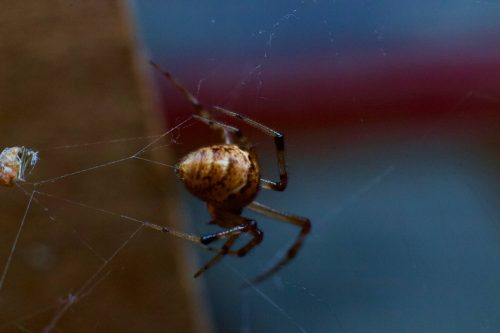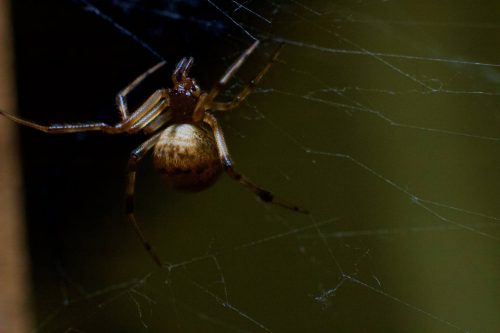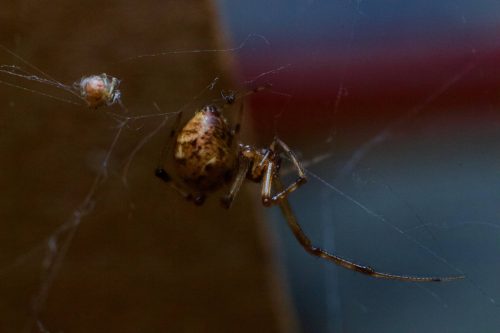Spider taxonomy drives me cross-eyed. Today I was working on sorting egg sacs, tearing them away from their mommies, who don’t like that one bit — they’re very protective. I’m learning to tell the different species apart without a microscope. For instance, Steatoda triangulosa has a distinctive zig-zag of pigment on their abdomen that looks like a row of triangles from above, and they also have nearly spherical egg sacs that are white, have a fluffy surface, and are often semi-transparent. Parasteatoda, on the other hand, has an irregular mottling that sometimes looks roughly stripey, and their egg sacs are football-shaped, beige, and have an opaque leathery/papery surface (there are two species of Parasteatoda around here, P. tepidariorum and P. tabulata, which I haven’t learned to distinguish — it requires careful scrutiny of their genitalia — and my live spiders refuse to sit still long enough to poke around their private parts). Those are my rules, they’re what helps me figure out who is what.
So today I’m parting Lyanna from her egg sac…here’s Lyanna:
She’s very pretty, isn’t she? Here’s more photos from different angles so you can clearly see her abdominal pattern.
Tell me if you agree: no triangles. Mottled. Kinda stripey. That’s Parasteatoda, definitely. No way could that be S. triangulosa.
Then I put her egg sac under the microscope, and it’s small, round, perfectly white with a fluffy texture, and I can see a small number of eggs right through it. If I saw it alone, I’d say S. triangulosa.
There are possible explanations, of course. Maybe there are common variations in egg sac morphology, and species just define a probability, so this is just an extreme in Parasteatoda morphology. Or there are variations in pigment pattern that are likewise probabilistic or environmentally influenced. Or I’m raising a hybrid. Or maybe species (or in this case, genera) have much fuzzier boundaries than I’m used to. Or maybe I’m just not very good at IDing spiders.
I never had this problem with zebrafish. It’s Danio rerio, that’s it, done. We never had to fuss over this taxonomy stuff.
May have to go mad. That’s OK, right? Mad scientists are perfectly traditional roles.






From a brief glance at Wikipedia, it looks as if these species have not been looked at in a modern fashion to determine what’s going on. Supposedly they are non-native. But often more non-native species are also present. Maybe you should contact a Theriid expert to ask. Collect a few voucher specimens into absolute alcohol for DNA investigation.
In dendrology, a similar problem is encountered when studying poplars and, at least in Europe, willows. They really, really like hybridizing and it is all too common to find specimens that are intermediate between two species.
Danio rerio without question but I bet that’s only because you never had to sort them out from other danionines from the wild.
Is this possibly a reason that some of the matings you encourage turn out to be feastings, instead? Not the right species of male?
Dr. Myers.
I would like to point out here why, in a previous post you are utterly wrong. And to start, I will say I am partially to blame. You stated:
“By the way, I had a couple of them scampering about on my hands just an hour ago. I know how aggressive they are…not at all.” This is probably a true statement. However, you are not handling Nobel False Widows. They are not indigenous to North America.
The Nobel False Widow, (Steatoda nobilis) of six sub-species is the largest, most aggressive and poisonous spider in the UK.
in your lab you are dealing with either (Steatoda Paykulliana) or (Steatoda grossa) or even (Steatoda triangulosa), smaller and far less aggressive and native to the upper mid west.
Stetoda Nobilis has been spotted in Calf. But it’s numbers are not yet well known.
Although bites are “rare” the number of cases have increased and it’s bite is still.considered “medically significant. This is due to a significant portion of the population being allergic to the venom.
You are experiencing a common problem in the taxonomy of arthropods. I specialize in the taxonomy of genus Culicoides (Diptera: Ceratopogonidae) of the southwestern United States. Several subgenera are maddeningly difficult to clearly identify to species (so we are both mad scientists, eh). I have found populations that seem to show either hybridization or a much greater variability of some of the (supposedly) definitive key morphological characteristics than are indicated in the descriptions, or even some subgeneric revisions. In some cases, I have to use a preponderance of the evidence or decide which of several characteristics seem most important. Sometimes even type specimens are of little use for clarification because they have been collected in other areas with no knowledge of the geographic range or variability for the species. Good luck.
I work with S. borealis, S. triangulosa, and the related genus, Parasteatoda. They are all listed as “medically significant” because they have a venomous bite. More people die of bee stings than spider bites, however, and the greatest risk of a spider bite is infection, if untreated.
You have no evidence that S. nobilis is more aggressive than other false widows. Nothing I have seen or read suggests that they are, and to say that they are the “most poisonous” spider in the UK is not saying much. There is a scattering of anecdotes, but no evidence that they pose a serious risk to residents of the UK. It’s all hype and sensationalism.
Ok, but I wonder how many UK residents willingly let S. Nobilis routinely scamper around on their hands. I’d guess that this could rain the risk level quite a bit.
@8 Brian: Agreed. Dr. Myres cant admit his statement that he lets S. Nobilis run around his hands is wrong, even when I pointed out that he does not.
British Medical Journals, and news outlets both provide lists of steps to take if you suspect you have been bitten, and if you have more than a mild reaction to a bite. This is hardly “anicdotal”.
In America, it is easy to get data though the CDC. In the UK, it is Public Health England – Centre of Infectious Disease Surveillance and Control. I have found it is a lot harder to get actual data that isn’t “anicodtal” This is because 1) any spider bite that is mild, is unlikely to be reported. (Survivor Bias) 2) It is difficult sometimes to determine conclusively what caused a bite. 3) The admittedly sensationalism of the stories that do.
BUT to use an analogy: Just because you mostly hear stories of car accidents that are fatal -DOES NOT – mean most car accident stories are anecdotal.
These are easy to identify:
https://www.abc.net.au/news/2019-09-12/redback-spider-catches-mouse-in-rare-moment-captured-on-film/11501206